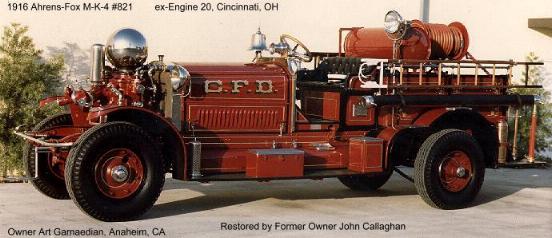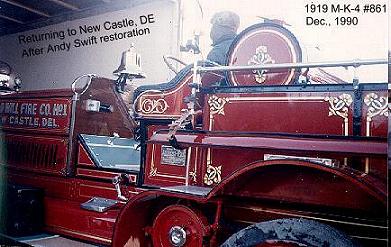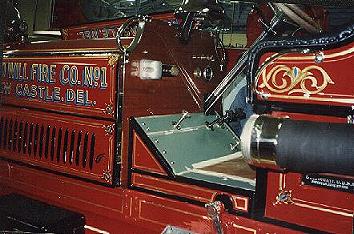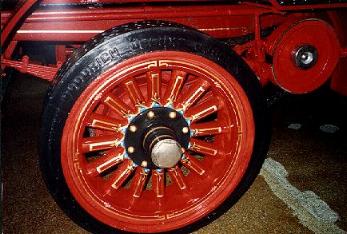









Close-up of pump on 1913 Ahrens-Fox Model A #515 of Circleville, OH, shows gold stripe across curved front-end of chassis frame. Stripe outlining pump body curves around the side suction inlet at the rear of the pump. Also note gold stripes outlining each leaf of the front springs.

Close-up of front wheel on 1913 Ahrens-Fox Model A #515 of Circleville, OH, shows stripe between each bolt-head on the wheel rim, and decorations on each wooden spoke. Also note the stripe around the wheel's hubcap, and the mouth-shaped gold stripe outlining the forward edge of the front fender.

1916 Ahrens-Fox Model M-K-4 #821, ex-Cincinnati, OH, as restored by John Callaghan of Grand Blanc, MI, and now in a museum in Germany. Note that only the hosebed has corner scrolls. The hood, front and sides of the seat riser, splash panel to the running-board, and tool boxes all feature plain gold stripes without corner scrolls or white accent stripes found on later Foxes. However, note that the edges of the hood, driver's floorboard and toeboard, seat riser, hosebed, and rear fenders are all outlined in black. This was a common practice on early fire apparatus: the black edging hid dents and scratches better than red paint did, and was easier to touch-up in the firehouse.

Authentic reproduction of original corner scroll on hosebed of 1916 Ahrens-Fox Model M-K-3 #812, ex-Piqua, OH, restored by Ray Kehrhahn.

Hood of 1916 Model M-K-3 #812 ex-Piqua, OH. Note the traditional Ahrens-Fox dark green and light green shading around the gold-leaf lettering. Also note the plain gold striping on the hood, without corner scrolls or white accent stripes found on later Ahrens-Fox apparatus.

One of America's top restorers of antique fire apparatus, Andy Swift of Hope, ME, restored this 1919 Ahrens-Fox Model M-K-4 #861, owned since new by Good Will Fire Company of New Castle, DE. When New Castle delivered the rig toi Andy's shop, it still bore its factory original paint and gold-leaf, which Andy faithfully reproduced. The view shows the corner scrolls on the hosebed, and their smaller versions on the corners of the hood and the seat riser. Also note the scrolls on the booster tank and the seat riser, and the stripes on the driver's floorboard and toeboard, and on the frame.
Below is a closer view of the scroll on the seat and seat riser, and some of the lettering and decoration on the hood.


Andy Swift carefully reproduced the elaborate decorations on the rear wheel of 1919 Ahrens-Fox Model M-K-4 #861 for New Castle, DE.
Serifs are the stems at the ends of lettering. Ahrens-Fox used both sans-serif (no stems) and serif (stems) in lettering the hoods of fire engines. But 1916 Model K-3 #625 of Friendship Fire Co. No. 5, Carlisle, PA, was unusual for using both lettering styles on the hood. The top line is sans-serif (note lack of stems on the ends of the F in Friendship), while the bottom line has serifs (note the stems on the F in C.F.D.). Both lines of lettering fdeature red shading, not the dark-green and light-green shading that would appear on all Ahrens-Fox apparatus from 1922 to 1958. Also note the single gold stripes on the hood, cowl, footboard, and frame (later Foxes had white accent stripes to highlight the gold stripes), and the absence of decorative corner scrolls that would adorn later Ahrens-Fox hoods.
Model J (1919-1930) was designed to be, and was heavily promoted as, the pinnacle of Ahrens-fox quality, both mechanically and in terms of finish (paint and gold-leaf). Mechanically, these were the first Foxes to feature shaft drive and T-head motors with cylinders cast in pairs instead of cast separately. Registered #953 of East Chicago, IN, and Registered Number 955 of Detroit, MI, provided classic illustrations of the claim for superior finish.
Only slightly less ornate than the shaft-drive Model J, were the more standard Models K, L, M, N, and P of 1917-1922. 1920 Model I-K-2 of Evansville, IN, shows typical gold-leaf on these models for the late Teens and early Twenties. Note unusual lettering style on hood, with curled serif ends, possibly unique to Evansville. Note that the corner scrolls on the hood are also used on the seat riser, and a larger version of the same scroll appears in the corners of the sidewalls on the hosebed. Also note the white accent stripes to the interior of the gold stripes, and the decorations on the front wheel rim and spokes. Rear fender featured black edging, and gold and white stripes. Evansville bought six identical pumpers like this one in 1920; Registered Numbers were 777 through 782.